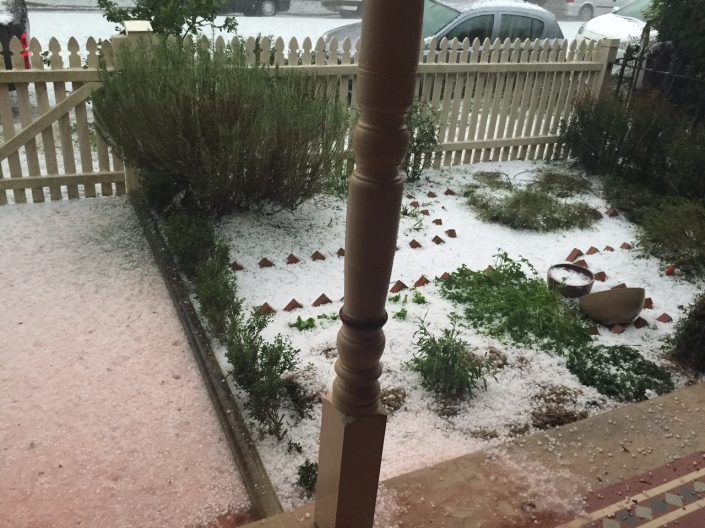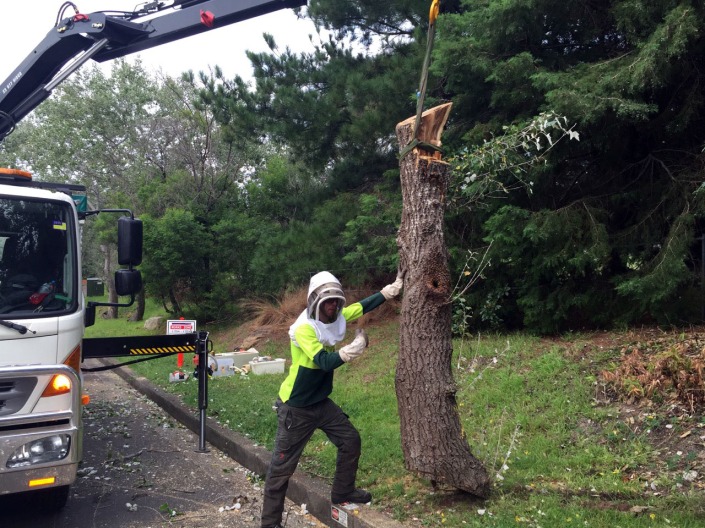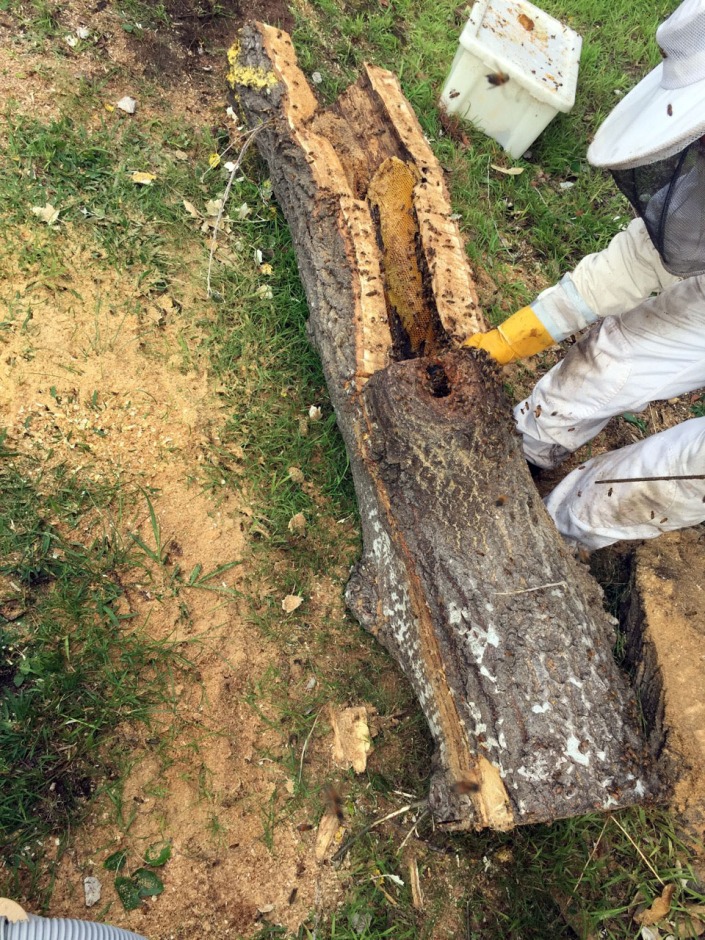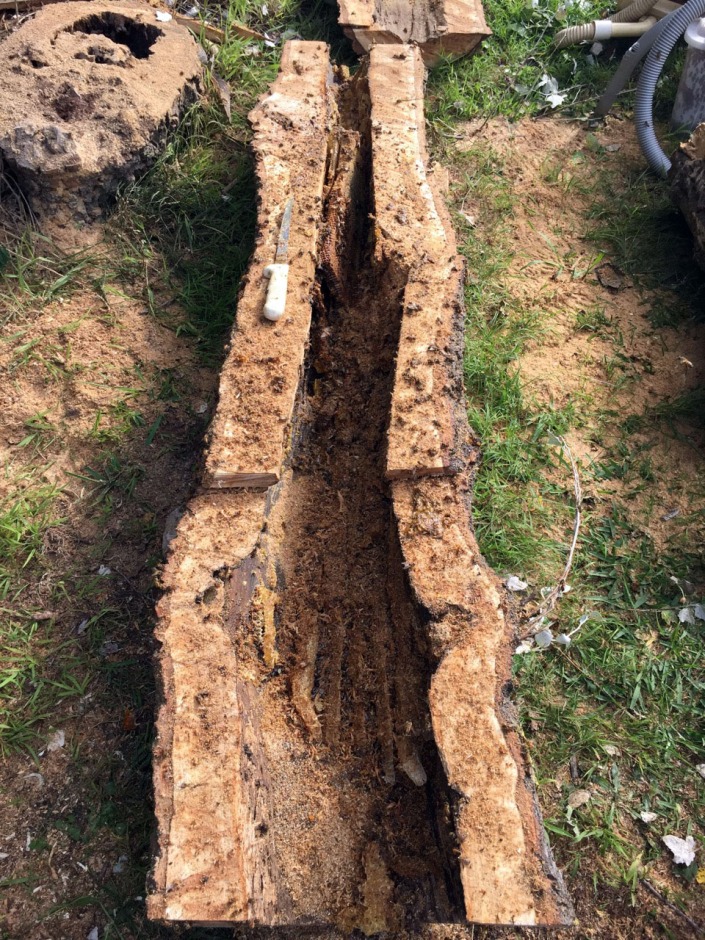Local issues
Cleaning the gunk out of our water tanks
It’s coming up on eight years since we installed our first 5000L water tank, put in during drought conditions. Since then we’ve added two more tanks as part of the renovation.
Over Christmas, when we had three dry months, our tanks dropped to nearly empty. They also started to stink, clearly the results of anaerobic decomposition of the plant material washed off our roof. Smelly water feeding into the washing machine, not good!
Our setup has first flush diverters, designed to capture the first lot of dirty water that flows into the gutter. They’re not magic, however, and gunk still gets in to the tanks, and builds up over time.
In the country, where households have to rely exclusively on their water tanks, it’s routine to get them cleaned out every while. I haven’t heard of it being done in the city, however. This might be because most of the tanks were put in at the same time as us, or later, and the problems are only now starting to emerge.
When we were out at a country show, we collected a business card from Leigh’s water tank cleaning, who we talked into dropping by our place when he happened to be heading into the city. We also talked to the Water Tank Cleaning Company who operate throughout Sydney (their website was down at the time of posting).

Leigh was very friendly, the the process is surprisingly simple. It’s basically a hand-manoeuvred version of a pool cleaner, which is steered around the base of the tank where the gunk has accumulated.

It’s somewhat horrifying to see how much dark brown water gushes forth. No wonder our water filters kept getting clogged up, trying to deal with all that!

It’s a quick process, and within half an hour, our two main tanks were done. That should keep them going for a few years…
Weedy resources from the Department of Agriculture
Whether you’re in the city or the country, you have to wage a constant war on weeds. Many are hard to kill, some are poisonous.
Others, however, are hard to identify. And if you don’t know what it is, how do you know whether to pull it out (and how)?
When down at the recent Small Farm Field Day, I visited the stand manned by the Department of Agriculture. They pointed me to an excellent phone app, called NSW WeedWise.
This contains a comprehensive collection of weeds, including photos and descriptions. It also indicates how serious a weed is, and whether you’re required to destroy it.
A lot of the weeds I already knew about, but I was pleased to learn about Moth vine. This looks quite like choko, and it’s growing on the back fence of the convent.
Far from being edible, however, it has sap that’s poisonous, and it spreads itself liberally when the seed pod bursts open.
Another day, another weed. Download the app from the Apple Store or Google Play.

Railway passage garden going strong

Back in 2014, I started planting alongside the pedestrian pathway that runs from Lewisham Station through to West St. There have been ups and downs, but I’m now up to 30 metres of garden, with a mix of small trees, bushes and ground covers (all natives).
And then I paused, as I’d been reported to the council for planting trees (shock horror!).
I ended up having a visit from the tree officer at Inner West Council, who turned out to be delightful. Not only did he approve of the work (his first question was: “are you going to do the rest?”), but he offered some free trees.

A month or so later, the council planted eight Lilly Pillies, plus a variety of other trees. This has doubled the length of the garden, to approximately 60 metres. Which is about half of the entire length of the passageway. Now we’re getting there!
I offered to mulch under the council trees, so I collected free cardboard boxes from the recycling bins at Pig and Pastry, plus free mulch from the Council. Two full ute loads of mulch later, I’m only half way. Phew! Still it’s good exercise, and there’s a palpable sense of progress now.
I’ll be at this for a few years yet, so say hi if you see me working away. And any volunteer help would be gratefully received!
Who knew? Possums like honeycomb
A family of possums live in the trees behind our house, and every night they walk across our roof and around our back fence. While adorable in theory, in reality they ate our green roof, nibble on our ferns, and when really hungry, head to the front garden to munch through our vege patch.
What we recently discovered is that they also love honeycomb.

To extract honey, I use a fruit press to squeeze the honeycomb. What’s left over is a thick lump of wax, honey and detritus. I left this on the back verandah for the bees to re-collect the honey, back into the hive.
One night, when watching TV, we heard heavy movements on the varandah. Turning on the lights, there was a possum, munching through the lumps, as bold as day. It was so fearless, I had to wrestle the tray off the possum, who was very reluctant to let it go.
The next night, we found the possum munching the left-over bits off the honey press. The cheek!
Who knew that possums love honeycomb?

Success: catching a swarm in a bait hive
A few years back I reviewed the excellent ebook Swarm Traps and Bait Hives. This outlines the simplest way to get free bees: lure a local swarm into a ‘bait hive’ placed at a strategic location.
The idea is that the temporary hive is a more attractive option that a tree hollow, a chimney or the cavity in the walls of a house. Once the bees have settled into the bait hive, it can be moved to a new location, and established as a permanent hive.
This season I set up a number of bait hives. These consisted of two boxes with frames, a flat lid, and a specially-made base. Out of the five bait hives I established, I had a success with one. Pretty good, considering that the strange weather this year really limited the number of swarms that were about.
Watch the video above to see my bait hive strapped to the side of a tree.
Hollow trees: the natural home for bees
I’ve always known that hollows in trees are the natural home for bees, but this was reinforced when several trees were cut down over the road.
The camphor laurels were lifting the foundations of the church, and weren’t in a great state anyway. So they had to go.

The pieces of trunk left behind demonstrate clearly how big a hollow can be within a tree. No wonder I keep finding wild hives in camphor laurel trees, including two in nearby Petersham Park.

Making progress with our railway plantings

The key to guerrilla gardening is to be indifferent to the survival of any one plant, while remaining passionate about the success of the garden as a whole.
In the year since I last blogged about our guerrilla gardening along the railway line, there has been plenty of progress, and a fair share of setbacks.
First the challenges:
- The railways folks decided to replace the electricity substation right next to the garden, leading to trucks being squeezed down the pedestrian pathway, crushing a pile of plants. (Their reworking of the security fence also killed off a bunch more.)
- Pretty much all of the groundcovers were wiped out by the big hailstorm.
- Local kids keep stealing the stakes used to hold the plant guards.
- Plants are randomly damaged, by dogs or passing people.
- Some plants simply don’t survive the harsh conditions.
But the good news:
- The garden has been progressively extended, and it’s now 10+ metres in length.
- The more established plants are now growing strongly, including all the acacias and callistomons.
- I’ve grown most of the plants from cuttings, so the cost has been minimal.
- Surprisingly few plants have been stolen.
The key is to keep planting each weekend, to replace the 2-3 plants that are damaged, and to then get slightly ahead. Over a year, this makes a big difference, and the pace should progressively increase.

I’ve had plenty of great comments from the locals, and it’s an enjoyable challenge. While it’s still early days, I think I’ve proved that one person can have an impact.
What can you do in your local area? 🙂
And the storm came pounding in
We were glad to make it back before the storm hit. As the sky darkened, rain started sheeting down. We were watching through our back windows when — look — it’s hail! How exciting is that!


The hail kept coming in, pea sized, but overwhelming in numbers. Before long, the ground was white, as if it was a European winter scene.


And then — water — it’s leaking! — and then pouring! into the house through the ceiling. Damn!
It was the ice piling up on the flat roof, and causing the water to flow up, over the flashings and into the ceiling. Up I went onto the roof in the middle of the storm, with a stiff-bristle broom.
For 30mins I swept the hail into piles, away from the flashings and other vulnerable points. The roof simply wasn’t designed for this, and anywhere it could get in, it did.
By the time I came back down, water was still pouring through the light fittings, and we’d been plunged into darkness. Thankfully the ceiling held, unlike some of our neighbours, who had their gyprock ceilings collapse on them while watching TV.


The garden suffered badly. While the big trees were stripped of leaves, the smaller natives shrugged it all off. The vege patch and herbs, however, were destroyed. Pounded into the ground, until a mush.

Some will recover, but some won’t. There goes much of our winter crops…

The life of an urban farmer isn’t an easy one. They say this was a once-in-40-year storm. Considering we’d suffered a once-in-a-decade superstorm (600mm over 48 hours) earlier in the same week, I’m not putting money on it…
Rescuing bees from a rotten poplar tree

A week ago I received a call from Gavin, my bee buddy, about a wild hive in a local tree. The bees had made their home in the hollow trunk of a poplar tree, one of a row of trees that were all marked to be removed as part of a native revegitation activity by Marrickville Council.
The arborists were up for helping remove the hive, as long as some beekeepers were ready to deal with the actual bees.

The starting point was to take off the top of the tree, which the arborist did at the highest point he could reach. The hollow extended past the fork of the tree, and a small number of bees immediately started using their new hive access…

With the support of the on-truck crane, the arborist (equipped with a borrowed veil) cut through the base of the tree. It was then laid down on the ground, read for us to start work.

It was amazing to see how rotted out the tree was, and apparently this is a common problem with poplars. (Of note, there’s research that says that bees benefit from fungi, which assists their immune systems.)
Once the tree was on the ground, I started vacuuming up the bees using a ‘beevac’. This is essentially the same as a sawdust collector that catches material before it gets to the vacuum cleaner, only in this case it’s a collector for bees. (Sorry, no photo of this, I was too busy using the beevac!)

With the further assistance of the brave aborist, we opened up the hive, by chainsawing off slices of the trunk. We were then able to cut out and remove the comb, which was a mix of brood and honey.

Once we’d worked our way along the full length of the trunk, it became fully apparent how large the hive was. It was a very healthy colony, with no signs of pests or diseases, and plenty of activity.

Once finished, we emptied the box of vacuumed-up bees into a Kenyan top-bar hive, along with the brood comb. We then left the bees to hopefully settle into their new home.
What surprised everyone was how relaxed the bees were. Despite attacking their home with a chainsaw over the period of an hour, they didn’t go on attack. The aborist received one minor sting on his wrist where his glove had pulled up, but there were otherwise no stings at all.
A truly amazing morning, and great experience for a new beekeeper such as myself.
(Postscript: the bees decided they didn’t like their new home, and the flew away the following day. Ah well, at least they were saved from the woodchipper, and hopefully they’ll find themselves another good home. Better luck next time for us beekeepers!)
Why you shouldn’t plant citrus trees in the verge

Before Lewisham, we lived in a unit in Chippendale. Surrounded by the local guerrilla gardening of the verge, we were equally enthusiastic when we moved into our new house.
We remain strong supporters of the principle of gardening the verge (nature strip). We’ve learned along the way, however, a bit about what works and what doesn’t.
What works in the verge
There are many possibilities for gardening the verge, while staying in local council guidelines.
“Pick and come again” mediterranean herbs work particularly well. They’re tough, attractive, and useful for office workers heading home to make their evening meal. Olive trees and bay trees also work well, acclimatised as they are to tough conditions.
There are plenty of native plants that work well in the verge, from low-running ground-covers and strap-leaf grasses, through to hardy bushes and small trees. (We’re quite pleased with our native verge.)
What doesn’t work in the verge
Our biggest lesson is that citrus trees don’t work well in the verge. Since this is the hardest learned lesson for us, it’s worth sharing a few specific reasons:
- Citrus trees are gross feeders. That is, they require a lot of food, throughout the year. Without this, they remain stunted and fruit-less. (For example, for us to get lots of limes, we greatly ramped up our feeding regimen.)
- Citrus are attacked by bugs and diseases. There’s practically nothing that they aren’t attacked by, including citrus leaf miners, stink bugs, aphids, thrips and citrus gall moth, to name just a few.
- Citrus aren’t set-and-forget. For the reasons listed above, citrus need constant monitoring and care, for their entire lifetime.
- They get stolen. Mirroring the experience in Chippendale, three of our four citrus trees were stolen in the first fortnight, the last being left only because it looked so poor.
- People are impatient. While the whole idea of edible plants in the verge is to share the bounty, we’ve found that the fruits get taken well before they’ve even ripened.
- People are careless. More often than not, a whole branch will be ripped off, rather than a single fruit twisted free.
In short, don’t plant citrus. Beyond this, each local council will have guidelines about what not to plant. Large street trees are typically seen, for example, as the sole domain of the council to plant.
But there are plenty of other options! May your verge live well and prosper.